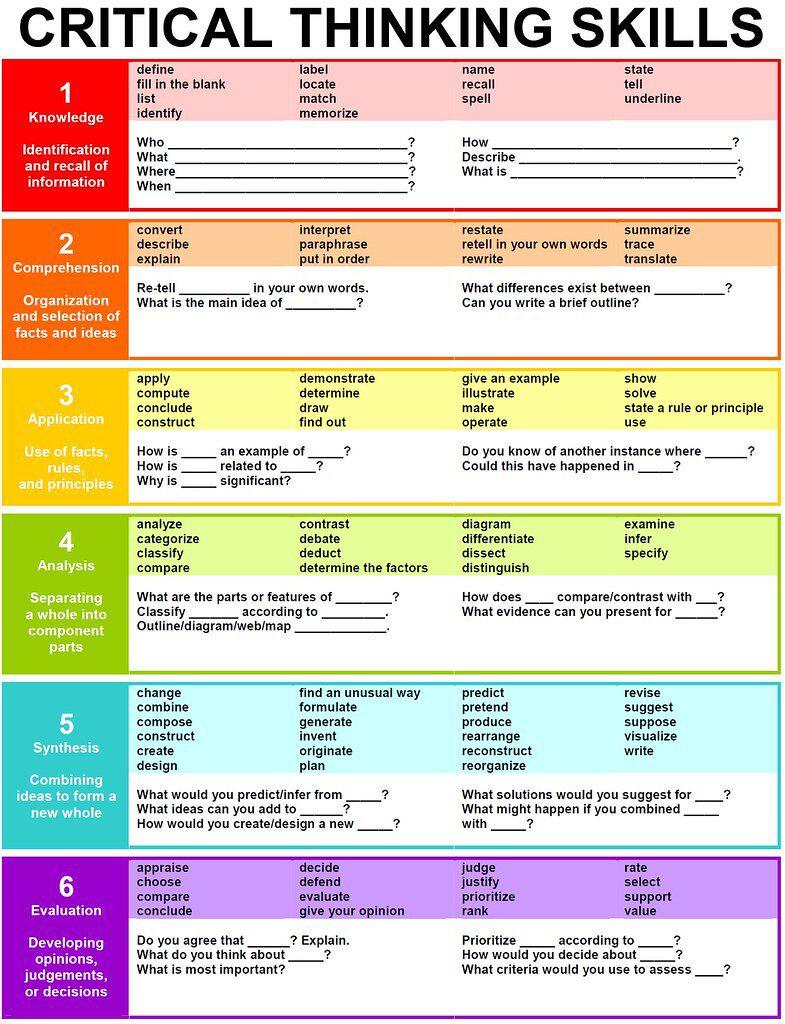. . . the art of thinking
#CriticalThinkingSkills #CollaborativeDesignTeamProcess

Critical thinking is a cognitive process that involves actively and objectively analyzing, synthesizing, and evaluating information or ideas to make reasoned judgments or decisions.
It encompasses a range of intellectual skills and dispositions that are essential for effective problem-solving and decision-making.
The critical thinking process can be broken down into six key areas: knowledge, comprehension, application, analysis, synthesis, and evaluation. Let's explore each of these areas in detail, providing examples to illustrate their importance.
Knowledge
Knowledge is the foundation of critical thinking. It involves acquiring information and facts about a particular subject or topic.
Critical thinkers must have a solid base of knowledge to draw upon when evaluating information or making decisions.
For instance, a student studying history needs to have a factual understanding of historical events and figures to critically analyze their significance.
Comprehension
Comprehension goes beyond mere knowledge; it involves understanding the meaning and significance of the information acquired.
Critical thinkers should be able to interpret, explain, and summarize complex ideas or concepts. This skill is crucial for identifying the key elements within a given context.
Application
Application is the ability to use knowledge and comprehension in practical situations. It requires critical thinkers to transfer their understanding to solve real-world problems or make decisions.
This skill bridges the gap between theoretical knowledge and practical action.
Analysis
Analysis involves breaking down complex information into its constituent parts to examine their relationships and identify patterns or connections.
Critical thinkers use this skill to deconstruct arguments, identify biases, and detect logical fallacies.
Synthesis
Synthesis is the process of integrating information from different sources or perspectives to create a coherent and well-structured understanding of a topic.
It requires critical thinkers to combine various elements to form a new and holistic view.
Evaluation
Evaluation is the final step in the critical thinking process. It involves making judgments or assessments based on the information, knowledge, comprehension, application, and analysis.
Critical thinkers evaluate the validity, credibility, and relevance of information and arguments to arrive at reasoned conclusions.
To illustrate the interplay of these six areas, let's take a scenario involving a critical thinker, Sarah, who is evaluating a new dietary trend called the "Superfood Diet" to determine if it's a healthy and sustainable choice.
1. Knowledge: Sarah starts by gathering information about the Superfood Diet. She learns that it emphasizes foods like kale, quinoa, and blueberries, claiming they provide exceptional health benefits due to their nutrient density.
2. Comprehension: Sarah delves deeper to understand the core principles of the Superfood Diet. She comprehends that it promotes the consumption of foods rich in vitamins, minerals, and antioxidants, with the goal of improving overall well-being.
3. Application: Sarah applies her comprehension of the Superfood Diet to her own life. She considers whether she can realistically incorporate these foods into her daily meals and assesses the potential impact on her health.
4. Analysis: Sarah critically examines the claims made by proponents of the Superfood Diet. She analyzes scientific studies on the health benefits of the recommended foods, looking for potential biases in the research and any conflicting evidence.
5. Synthesis: Sarah synthesizes the information she has gathered, combining her knowledge of the diet's principles with her analysis of the scientific literature. She forms a comprehensive view of the Superfood Diet's potential advantages and drawbacks.
6. Evaluation: Finally, Sarah evaluates the Superfood Diet based on her synthesis of information. She considers whether the diet is a sustainable long-term choice, taking into account her own dietary preferences and lifestyle. Sarah also assesses the credibility of sources promoting the diet and makes an informed judgment about its suitability for her.
In this example, critical thinking guided Sarah through a structured process, enabling her to make a well-informed decision about the Superfood Diet.
Each of the six areas played a distinct role in her critical thinking journey, reinforcing the importance of these skills in everyday decision-making.
In conclusion, critical thinking is a multifaceted cognitive process that encompasses knowledge, comprehension, application, analysis, synthesis, and evaluation.
These six areas are interdependent and collectively empower individuals to make informed decisions, solve complex problems, and navigate an increasingly information-rich world.
Developing and honing these critical thinking skills is essential for both personal growth and success in various professional fields, as they enable individuals to approach challenges with clarity, logic, and discernment.